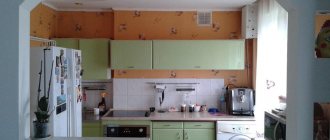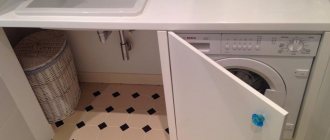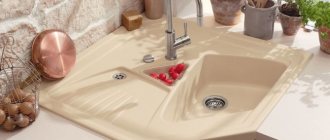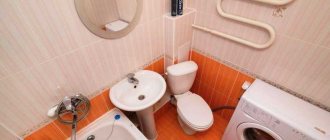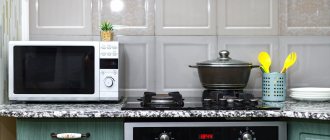It is difficult to imagine modern life without a washing machine: after all, it makes life much easier and saves time. Most often it is installed in the bathroom, but when the bathroom is too small, problems arise with the layout. How will a washing machine feel in the kitchen? Before choosing its final location, let's get acquainted with all the pros and cons of such placement.
Advantages
The most important advantage: the bathroom does not take up precious space, and it becomes freer. But besides this, there are several more advantages that you don’t immediately think about.
Safety
According to fire safety rules, electrical appliances should not be placed in rooms with high humidity, which is the bathroom. The kitchen is a different matter, here the humidity is much lower, and most often there is a window that provides active air circulation.
Work zone
Usually the washing machine is hidden behind the facade or simply covered with a countertop. In both cases, a new work surface appears, which will never be superfluous in the kitchen.
Communications
It is convenient to install the washing machine in the kitchen, since the main communications are already there: both water supply and sewerage - there is no need to install anything additional. You just have to clarify how to connect the electrical wiring, because the machine requires a dedicated line.
Wash anytime
You can do laundry in the kitchen at any time, regardless of whether anyone is taking a bath. On the other hand, noise during spinning and draining can interfere with an evening family meal or watching TV.
But, according to reviews, the same hood is louder than a washing machine. You can run the wash at night: this way the machine will not disturb anyone, and your energy bills will be lower.
Utility room
An ideal option for installing a washing machine - here it does not bother anyone and does not take up useful space in other rooms.
Nowadays such technical rooms are becoming more and more popular; they appear not only in houses, but also in apartments.
In such a room it is convenient to place a washing machine and everything you need for cleaning - a vacuum cleaner, household chemicals, basins, mops. Storing these necessary, but not the most beautiful items, often becomes a big problem, and the presence of a technical room helps solve it comprehensively.
Flaws
Everything has both advantages and disadvantages. And the washing machine in the kitchen is no exception. But basically, the disadvantages are not related to the machine itself, but to its “extras”.
Storing dirty laundry
Dirty laundry has an odor, and if you store it in the kitchen, it will also absorb kitchen odors. And this means that it will have to be carried to the kitchen either from the bathroom or from another room. Some people find this very inconvenient - although in fact, there is nothing critical about it.
Storing powder in the kitchen
With powder the situation is more complicated:
- it can be scattered, which is undesirable in the room where food is prepared;
- it gives off a smell that is harmful to breathe.
There are several ways out of this situation:
- store washing powder in another room;
- switch to liquid laundry detergents;
- Store the powder in a container with a good tight lid.
ADVICE. It is most convenient to store the powder in the kitchen either next to the machine or under the sink.
Open door
After washing, the machine door should be opened and the drum ventilated to prevent mold from growing in the appliance. This can interfere with passage, especially if the machine is built-in - after all, you need to open not only the machine door, but also the cabinet door.
Difficulty of change
Once the machine is already installed, it is difficult to move it somewhere else, since pipes and electrical wires are laid. But this applies not only to the kitchen, but also to other rooms.
Spoils the appearance
This does not apply to all washing machines, but only those not hidden behind the facade. Dirty laundry stored inside looks especially unsightly.
ADVICE. To make the machine look neater, you should match it to the kitchen facades, or decorate it with vinyl stickers of the same color.
If both options are not suitable, then the machine is hidden behind a beautiful matching curtain. This is especially true for kitchens in the style of Provence, Country and others.
Where else can I put it?
But don't think there aren't alternatives to the options above. If you try, you can install the washing machine in other places in the apartment.
1. Toilet. If the toilet is separate from the bathroom, you can install a top-loading machine next to the toilet. For those who like original solutions, the option of hanging the washing machine above the toilet is suitable. You can find a model on sale so that water after washing accumulates in the drain tank and is flushed into the toilet, thus saving moisture.
2. Hallway. If you have a small kitchen and bathroom, you can consider installing it in the hallway. Of course, you will have to rack your brains a little, supplying water there, draining it and installing a special socket, but you will get a convenient table in the hallway for keys, umbrellas and bags.
If desired, the machine can be hidden in a closet or pantry. Just install it so that it is convenient to load and unload laundry.
3. Corridor. If the width of the corridor allows, you can install it in it, and place communications in the wall or hide them in the floor. Above the unit you can hang shelves or a cabinet where household chemicals will be stored.
4. Dressing room. If you have a dressing room, then you can safely install household appliances there. Here you can place both a dryer and an ironing board. So it will be a complete set.
5. Under the stairs. For residents of two-story houses or two-level apartments, the option of placing washing equipment under the stairs is suitable. If there is enough space there, you can hang shelves for storing washing supplies and put an ironing board, and hide this closet from prying eyes with doors.
Adviсe
There are several ways to reduce the disadvantages of placing a washing machine in the kitchen:
- if it interferes with the meal with its noise, then you can postpone the washing to night time. And it’s best to adjust its legs so that the equipment is installed perfectly level - so it will be practically silent;
- The noise is also affected by the floor covering on which the machine stands. It is worth giving preference to ceramic tiles - the quietest material. But if there is laminate on the floor, then there is a high probability that the neighbors will immediately know when your machine starts spinning the laundry;
- It is best to place the washing machine next to the dishwasher and sink, thus creating a “wet” corner. This makes it more convenient to supply water, and it will be easier to clean when everything is at hand. In a corner kitchen, for ergonomic reasons, the dishwasher is placed to the right of the sink, and the washing machine is placed to the left.
There are several ways to install appliances in the kitchen. They have no significant differences in characteristics, advantages or disadvantages.
Where to place the washing machine in the kitchen?
The ideal option is in close proximity to the sink.
After all, you will have to organize the drainage of waste water. There will also be a dishwasher nearby. You will only need clean water and drain adapters, and no additional pipes and hoses will be needed.
Full embedding
A built-in machine in the kitchen is beautiful because it itself is not visible, everything is hidden behind the facades. The unity of style is maintained, the room seems spacious and tidy. This is one of the most common options for installing equipment, but there are several disadvantages :
- the choice of built-in machines is not at all wide;
- the cost of such equipment is significantly higher than standard analogues;
- Difficult to access if repairs are required.
This option is suitable for owners of small kitchens, for example, in Khrushchev-era apartments, when it is necessary to visually expand the space.
Manufacturers of built-in appliances clearly indicate the dimensions of cabinets for installation in their instructions. Below you will find a diagram for installing the Candy CWB 1372DN1-07 washing machine.
And here is a diagram for installing a Whirlpool AWOC 0614 washing machine:
There is a built-in cabinet. This allows you to raise the machine to the desired height, without losing precious space, since there will be storage boxes or other equipment, for example, a microwave oven, under and above it.
In the hall
You can also install a washing machine in the hallway if you carefully consider all communications and camouflage. Hide your equipment in a built-in closet, wardrobe, or make a custom cabinet.
In the cabinet nearby you can store everything you need for washing: baskets for clean and dirty laundry, powders, conditioner and fragrance.
You can hide the washing machine behind a sliding wooden panel.
If you are still wondering which washing machine to buy, we offer two options: a built-in and a regular model from the Smeg store. Washing machines from the Italian manufacturer are of high quality and have many useful programs: pre-wash, cold and intensive wash, light ironing, extra rinse.
Built-in washing machine Smeg From RUB 96,840. +7
Smeg washing machine From RUB 121,490. +7
Partial embedding
If you don’t want to overpay for built-in appliances, you can put a regular front-loading washing machine in the kitchen and cover it with a countertop. Here it is worth considering its height, but the technique is quite standard - about 85 centimeters. The height of a standard tabletop is the same.
If a couple of centimeters are still missing, then you can remove the top cover of the washer: to do this, you need to unscrew a couple of screws on the back - this will give you a few centimeters. But then it is advisable to cover this area with either film or thin plastic.
There are two methods for partial embedding:
- without door;
- with door.
Let's consider these methods in more detail.
Without door
The essence of this arrangement is that the washing machine is simply placed next to the kitchen unit and covered with a countertop. In this case, it is important to attach the tabletop to the wall, and not just lean it on the equipment.
It turns out that the washing machine is closed only at the top, which provides a work area in the kitchen, but the machine is visible from the side. This is a plus, since it’s easier to take out and put down laundry, although aesthetically it doesn’t always look beautiful. This is where the advice of covering the equipment with a curtain, matching it, or decorating it with a vinyl sticker comes in handy.
This arrangement ensures mobility: if the machine breaks down, it’s easy to move it away and then push it back in. Therefore, this method is suitable for those for whom the main priority is convenience rather than beauty.
An example of such embedding can be seen in the photo.
With door
If you want to close the car, then a built-in one with a door is perfect. In principle, there is no actual installation here: the machine is simply placed in the kitchen unit. It is advisable to place it on the floor because the machine may shake. If this is not possible, then you should strengthen the base as much as possible: place bricks or solid wood boards under it, and also reinforce it with corners.
How to properly install and integrate an automatic washing machine under the countertop? Is this even legal?
Of course, you can’t install a standard machine like this, because it won’t fit. It is worth choosing among compact options with a depth of 45–50 cm. Their choice, unfortunately, is as small as that of built-in models, but they are more affordable.
With such an arrangement, you need to watch out for three things :
- a tray for powder - so that it does not rest against the hinges of the door of the unit, but extends out enough to add powder or pour in detergent;
- the location of the door - it is desirable that the car hatch and the door of the set open in one direction, otherwise it will be inconvenient to take out and put down laundry;
- having a margin of 2-3 centimeters on each side to prevent noise from washing.
Moreover, it is advisable to remove the back panel of the headset for air circulation and ventilation of the machine to avoid excess dampness.
Under the sink
Residents of Khrushchev-era apartment buildings sometimes take this step - installing a washing machine under the sink. This may not be the best solution, but in conditions of severe space saving, it has its place.
In this case, you need to pay special attention to the choice of washing machine under the sink:
- the height of the machine should be no more than 70 cm. Otherwise, it will be extremely difficult for small people and children to reach the sink, and they will have to substitute a stool;
- The depth of the washing machine built under the sink should be approximately 50 cm. In this case, it is necessary to take into account the gap behind the rear wall for communications and a flat siphon.
Sinks above the washing machine - Santekhniks.ru
You also need to choose the right sink. It should be a “water lily”, with a maximum height of 20 cm. For safety reasons, the drain should not touch the washing machine.
The advantages of such placement include saving space. Some even consider this layout stylish and modern. However, disadvantages here.
Firstly , these are the disadvantages associated with the small dimensions of the washing machine - neither a down jacket nor a blanket can be washed.
Secondly , the drain in a “lily pad” sink is prone to more frequent blockages.
Thirdly , for installation you will need a special siphon, which is not so easy to find.
Fourthly , there is a risk of water getting on the control board, which will lead to equipment breakdown.
Washing machine in the kitchen
In the kitchen
This is the second most popular place in the house to place a washing machine. Here it is also easy to connect it to communications. In addition, the kitchen is larger than the bathroom, making it easier to find space for a car here.
The washing machine can be placed under the sink, next to the countertop or in one of the cabinets.
Place a rubberized mat near the machine - this will protect your laminate from moisture.
Alternatively, just hide it behind a curtain.
Modern technology can fit even into the most romantic interior.
If you don’t want to hide the washing machine behind the doors, you can match it to the color of the kitchen unit - this way it will maintain harmony in the kitchen interior.
A black washing machine can be washed less frequently.
Beige or blue furniture looks good in combination with blue appliances.
Installation
When installing a washing machine in the kitchen, consider all the details: from the place and method of its installation. After all, what is important to you, first of all, is its ease of use and functionality. Therefore, please observe the following installation rules:
- There should be a gap of 3-5 cm between the equipment and the walls of the cabinet to prevent vibration;
- The surface on which the machine will be located must be flat, stable, and rough;
- It is necessary to ensure that the door opens freely;
- Rubberized pads are placed on the legs of the machine, which will ensure stability and sound insulation. Also, in the event of a breakdown, these pads will not allow electric current to pass through;
- If the kitchen also has built-in household appliances, they should not be located in close proximity to the machine.
Plinth installation
It is not recommended to place the machine on a plinth, as there is a high probability that vibration may cause it to fall from the stand. But if this is required by the size of the machine or the headset, then follow the safety rules:
- The stand must be strong and stable;
- It is better to use a factory model of the base; there is no need to build homemade stands;
- Use rubber pads for the feet.
There are advantages to using factory stands:
- They have drawers that are suitable for storing laundry detergents;
- The height of the base ensures ease of use;
- The base has special mounts for the machine.
Floor installation
Install the washing machine on a concrete surface, since the wooden floor will be damaged by vibration. But, since not all living spaces have concrete floors, you need to think about the safe installation of equipment.
The best option is to mark the place where the car will stand, carefully tear out the boards, and fill the resulting space with a concrete screed. For strength, a mesh of reinforcement is placed under the solution. After drying, the boards are put in place and strengthened. In addition, an additional 30 mm is left on all sides to the machine area.
Connection to communications
Incorrect connection to the water supply and sewerage will lead to a flood or even complete breakdown of household appliances. Therefore, correct connection is so important, which can be done independently, according to the instructions:
- Since the kitchen has neither a bathtub nor a toilet, it is necessary to organize a drain into the sewer pipes.
- Using an outlet, the drain hose is connected to the sink. That is why in the kitchen it is more convenient to place the machine next to the sink or under the sink.
- To ensure drainage, buy a siphon that will prevent water from flowing from the sewer into the machine.
- The instructions for use indicate the recommended height of the outlet hose.
- One end of the hose is connected to the rear wall of the machine, at a height of 70 cm, and the second to the siphon.
- Connect the drain hoses using clamps.
- Check the straightness of the hose.
Socket installation
Correctly connecting the washing machine to electricity ensures life safety. After all, in the event of a malfunction, the likelihood of emergency situations arises.
- Choose a high-quality socket, wiring, circuit breaker and residual current device with a certain level of protection:
- Electrification elements must withstand high loads;
- The socket for the machine must be separate and protected from ingress by a cover.
Do not install sockets on cold walls or near water sources!
As you can see, installing a washing machine in the kitchen has many advantages - it is convenient, practical and stylish!
Headset in the corner segment
We have already mentioned that top-loading machines are more difficult to integrate into the kitchen interior. There are only two options for placing it either against the wall or in the corner by removing part of the tabletop.
The second method is better, especially for small rooms: this way precious centimeters of space are not hidden. The only inconvenience is that it is not very comfortable to get things out. However, reviews say that it is quite possible to get used to it quickly.
A bonus is easier connection if you install the unit next to the sink - the necessary communications are located very close.
As you can see, it is impossible to clearly name the correct place to place the washing machine: it all depends on the configuration of the room, its dimensions and your priorities. However, we are confident that our recommendations will help you make the right choice.
